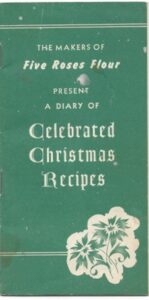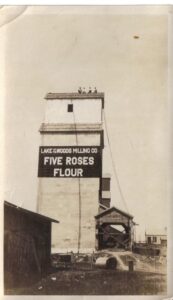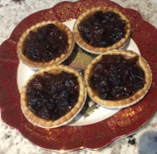A Diary of Celebrated Christmas Recipes
By M. Gale Smith
When an old friend visited me this summer, I mentioned to her that cookbooks were increasingly being used for historical research[i]. Shortly thereafter, she sent me two hardcover cookbooks and five cookbooklets that she found in her mother’s effects.
 One of the cookbooklets was a tiny little pamphlet – 3”x 5”, 31 pages – titled “A Diary of Celebrated Christmas Recipes.” It was produced by the Lake of the Woods Milling Company, the makers of Five Roses Flour and from all appearances was probably distributed free as there is a little note on page 20 saying “If you would like additional copies of “A Diary of Celebrated Christmas Recipes” for your friends write to Lake of the Woods Milling Co. Ltd., Winnipeg, Manitoba”. No mention was made of including money.
One of the cookbooklets was a tiny little pamphlet – 3”x 5”, 31 pages – titled “A Diary of Celebrated Christmas Recipes.” It was produced by the Lake of the Woods Milling Company, the makers of Five Roses Flour and from all appearances was probably distributed free as there is a little note on page 20 saying “If you would like additional copies of “A Diary of Celebrated Christmas Recipes” for your friends write to Lake of the Woods Milling Co. Ltd., Winnipeg, Manitoba”. No mention was made of including money.
It’s undated, but a few clues lead me to believe it was produced sometime in the late 1940s or early 1950s:
- This may be classified as a corporate cookbooklet. It was produced by “the makers of Five Roses flour”. Affiliations such as this with an institution rather than individuals began to appear at the turn of the 20th century. In the late 1930s when home economics became recognized as a profession, home economists were often engaged in creating these publications.[ii] On page 7 a little reference states “Recommended and Edited by June Horne, Home Economist.” That most likely narrows it down to the late 1930s.
- A note on the last page indicates you could order the “famous” Five Roses Cook Book, 191 pages for 40 cents.
Originally conceived in 1912 the Five Roses cookbook has had several editions (at least 25) over the years and is regarded as a landmark in the history of Canadian cookbooks. [iii] The first edition of the this “guide to good cooking” was released in 1913 as a collection of around 600 recipes submitted by women across Canada via a contest the company held. The book at that time cost about 25 cents, plus return postage in the form of a stamp.[iv] The price here at 40 cents means a later edition.
- A little note at the bottom of page 9 touts the superior baking qualities of Five Roses flour and stating “dependable, a favourite in Canadian kitchens for over 60 years.” The Lake of the Woods Milling Company was founded in 1887, with a mill in Keewatin, Ontario which became one of the largest flour mills in the British Commonwealth. Sixty years later would mean 1948 or later.
The cookbooklet has recipes and cooking tips under the following headings: Christmas Cake Making; Icings: Christmas Pudding; Pudding Sauce; Shortbread; Christmas Dainties; Sweets; Mincemeat; Roasting; Stuffing; Relishes; and Helpful Hints. Here is a recipe for almond paste among other specialty recipes.
Cookbooklets, like cookbooks, are valuable cultural artefacts that mirror many aspects of the society that has produced them. This one represents a fairly traditional view of foods associated with the holiday which reflects the colonial settler heritage of the country. Most of the directions are spare and somewhat vague and tools and equipment were seldom mentioned assuming that the cookery knowledge of women at the time was very high. Most of the recipes included flour and it was always FIVE ROSES flour. Little boxed messages scattered throughout read much like modern day commercials. This is not surprising as the main intent was promoting the brand.
The appearance of this little cookbooklet in Western Canada shows the influence of the railway in connecting the country and food production. The Canadian Pacific Railway (CPR) was formed to physically unite Canada and Canadians from east to west. Lake of the Woods Milling Company was started in 1887 by a group of Montreal-based investors affiliated with the CPR to take advantage of the railway and western grain production.[v] They constructed a large mill at Keewatin, Ontario [now Kenora] to process prairie-grown wheat into the Five Roses brand of flour.
The mill in Medicine Hat, Alberta is impressively large.
Source: https://archive.org/details/PC004398
They established other mills in Manitoba, Alberta and Ontario and built an extensive network of country grain elevators across western Canada, with their administrative headquarters in Winnipeg.[vi]
Source: https://www.grainelevators.ca/
The CPR completed its connection to British Columbia in 1885, and their product could be easily transported across Canada both east and west.
In 1954, The Ogilvie Flour Mills acquired Lake of the Woods Milling Company, along with its best-selling flour brand. Five Roses remained a part of the Ogilvie family until 1994 when the Archer Daniels Midland Company bought the entire Ogilvie operation. In 2007, the Smucker Foods of Canada Corporation acquired the Five Roses brand, where it remains today as part of a portfolio of successful and well-respected brands[vii].
In the Diary of Celebrated Christmas Recipes one recipe was labelled “modern” – mincemeat made without meat. Mincemeat pie also known as mince pie or Christmas pie, is traditionally associated with Great Britain and is said to have originated in medieval England after knights returning from the Crusades brought back spices. Typically the dish was made with minced bits of meat (from a range of animals) and suet combined with apples, sugar, raisins, spices much like the recipe labeled “Old Fashioned.” The “modern” version excludes the meat and suet replacing it with butter or shortening. It is very similar to the one that I make in the fall with apples and sometimes green tomatoes[viii] where even the butter or shortening has been eliminated. I process it in a boiling water bath canner to have at Christmas. It is so handy to just open a jar, fill tart shells and bake.
I wonder what other “modern” adaptions would be included if an updated Diary of Celebrated Christmas Recipes was created.
If you are looking for old heritage Christmas recipes to try you might like to read the whole cookbooklet. It is available from the Culinary Historians of Canada[ix]
[i] Elizabeth Driver (2009) Cookbooks as Primary Sources for Writing History, Food, Culture & Society, 12:3, 257-274, DOI: 10.2752/175174409X431987
[ii] Cooke, Nathalie. 2009. “Cookbooklets and Canadian Kitchens”. Material Culture Review 70 (June). https://journals.lib.unb.ca/index.php/MCR/article/view/18161.
[iii] Driver, E. (2008). Culinary Landmarks: A Bibliography of Canadian Cookbooks, 1825-1949. Toronto, ON: University of Toronto Press.
[iv] https://www.cbc.ca/news/canada/calgary/recipes-with-julie-calgary-vintage-cookbooks-1-1.5213785
[v] https://profilpelajar.com/article/Lake_of_the_Woods_Milling_Company#cite_note-manitoba-1
[vi] https://www.mhs.mb.ca/docs/business/lakeofthewoodsmilling.shtml
[vii] https://www.fiveroses.ca/FiveRoses/History
[viii] https://www.bernardin.ca/recipes/en/green-tomato-mincemeat.htm?Lang=EN-US
[ix] https://www.culinaryhistorians.ca/wordpress/wp-content/uploads/2020/10/Celebrated-Christmas-Recipes.pdf






Leave A Comment
You must be logged in to post a comment.